| |

Aloha. Before I start telling you about the wonderful things I saw in Hawaii, I want to thank everyone from Mr. Weltner's fifth grade class in Cranberry, Pennsylvania for all the terrific emails. What great questions you all asked!
Karen and I spent our last day of this adventure in Pearl Harbor. In her journal, Karen tells you all about our experience at the USS Arizona Memorial. I'm going to tell you about the other submarines and ships we saw, in particular the USS Bowfin and the USS Missouri.
Pearl Harbor Submarines
In Pearl Harbor, directly next to the Arizona Memorial, are the USS Bowfin and the U.S. Submarine Museum. Since I'm an underwater kind of guy, I decided to learn more about World War II submarines.
One of the things I learned at the museum is that during the war, 288 U.S. submarines went on patrol. Of these submarines, 52 were destroyed in action and one out of four men serving on subs died. Although submarines accounted for less than two percent of the naval forces, they were responsible for sinking 55 percent of all enemy ships.
Let's take a closer look at the USS Bowfin.
(Click on any photo to enlarge it.)
Touring the USS Bowfin |
The USS Bowfin, World
War II diesel submarine. |
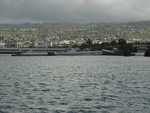 Come with me as I take you on a tour of this WWII attack submarine. The USS Bowfin was a diesel-driven submarine, launched on December 7, 1942. It had a crew of 83 men and was nicknamed the Pearl Harbor Avenger.
Come with me as I take you on a tour of this WWII attack submarine. The USS Bowfin was a diesel-driven submarine, launched on December 7, 1942. It had a crew of 83 men and was nicknamed the Pearl Harbor Avenger.
Tom in the torpedo room.
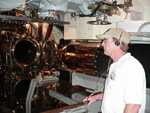 This is the bow torpedo room. You can see the torpedo tubes just in front of me. I am also standing next to a torpedo. Aside from storing torpedoes, this room was used as a bunkroom. Up to 8 sailors could sleep in the torpedo room. There is another torpedo room in the very rear of the sub.
This is the bow torpedo room. You can see the torpedo tubes just in front of me. I am also standing next to a torpedo. Aside from storing torpedoes, this room was used as a bunkroom. Up to 8 sailors could sleep in the torpedo room. There is another torpedo room in the very rear of the sub.
Follow Karen and me through the hatch into the next section of the submarine.
Karen coming through hatch.
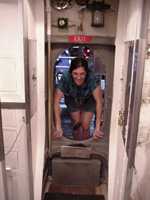
The captain's bunk
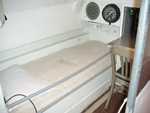 The captain was the only person on board who had his own room. Although it was very small, it gave the captain a place to be alone, rest, complete his important paper work, and make big decisions. Notice the depth gauge just above his bunk. It was always important for the captain to know the depth of his submarine.
The captain was the only person on board who had his own room. Although it was very small, it gave the captain a place to be alone, rest, complete his important paper work, and make big decisions. Notice the depth gauge just above his bunk. It was always important for the captain to know the depth of his submarine.
The com tower
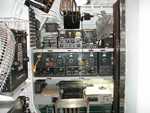 Next, we entered the small communication room, a tiny space to store and use all the radios and sonar equipment. Right next to the communication room is the control room, where the steering wheels and depth gauges for the sub are located.
Next, we entered the small communication room, a tiny space to store and use all the radios and sonar equipment. Right next to the communication room is the control room, where the steering wheels and depth gauges for the sub are located.
The mess hall
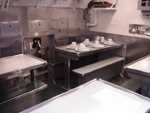 Attached to the kitchen is the mess hall. Up to 30 men could eat in this room at one time. Since men on submarines lived in such a confined environment, to keep up morale they were fed some of the best food in the navy. The mess hall also served as the recreation room. Sailors would read books, write letters, and sometimes watch movies here. Any important messages from the captain would also be posted on the wall in this room.
Attached to the kitchen is the mess hall. Up to 30 men could eat in this room at one time. Since men on submarines lived in such a confined environment, to keep up morale they were fed some of the best food in the navy. The mess hall also served as the recreation room. Sailors would read books, write letters, and sometimes watch movies here. Any important messages from the captain would also be posted on the wall in this room.
The bunkroom
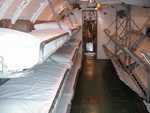 Up to 30 men at one time would sleep in this bunkroom. But remember that this ship had a crew of 83 men on board. How did they all sleep? Sailors on the USS Bowfin had to share bunks. While one group of men was working, the other group of men would be sleeping. Sailors had a nickname for this bunk-sharing situation. They called it "hot sheeting" -- you would always get into a bunk that had been warmed by the man before you.
Up to 30 men at one time would sleep in this bunkroom. But remember that this ship had a crew of 83 men on board. How did they all sleep? Sailors on the USS Bowfin had to share bunks. While one group of men was working, the other group of men would be sleeping. Sailors had a nickname for this bunk-sharing situation. They called it "hot sheeting" -- you would always get into a bunk that had been warmed by the man before you.
The diesel engine
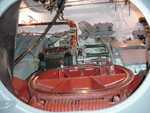 Just on the other side of the bunkroom is the engine room. This engine is a 16-cylinder, 1600-horsepower diesel. Four such engines gave power to this submarine. In addition to powering the submarine when it was on the surface, the engines were also used to charge the batteries. When the submarine was underwater, sailors would shut down the diesel engines and use batteries to run the sub. To remain undetected, most submarines would only surface at night to recharge their batteries.
Just on the other side of the bunkroom is the engine room. This engine is a 16-cylinder, 1600-horsepower diesel. Four such engines gave power to this submarine. In addition to powering the submarine when it was on the surface, the engines were also used to charge the batteries. When the submarine was underwater, sailors would shut down the diesel engines and use batteries to run the sub. To remain undetected, most submarines would only surface at night to recharge their batteries.
USS Missouri (BB 63)
After visiting the USS Arizona Monument, Karen and I realized how difficult it was to get an idea of the immense size of the Arizona, so we took a quick trip over to the USS Missouri for a tour. The USS Missouri (called BB 63) is an Iowa Class Battle Ship. The BB stands for Bombardment Battleship. This huge ship is nearly the length of 3 football fields (887 feet). In comparison, the largest wreck that Karen and I dove on in Chuuk Lagoon was around 500 feet in length. The USS Missouri saw action in WWII, Korea, and during Operation Desert Storm.
At the end of WWII and as a last ditch effort, the Japanese sent waves of suicide attack planes known as Kamikazes against American ships. On April 11, 1945 a Kamikaze was able to break through the Missouri's formidable anti-aircraft defense. It crashed on the starboard stern side of the ship, setting it on fire.
When the war was ended, the wartime powers chose the Missouri as the setting for the signing of Japan's Formal Instrument of Surrender on September 2, 1945. The signing of this document by both the Japanese and the Allied Powers brought an end to World War II.
Karen and I were lucky enough to have time to tour this huge battleship.
The USS Missouri, WWII battleship
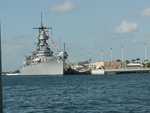 |
|
This is the USS Missouri. It is the fourth ship and the second battleship to bear the name of the "Show Me" state. This ship was the last battleship commissioned by the U.S. and in 1992 was the world's last operational battleship. |
16-inch bow guns
| These 16-inch guns could be fired separately or together. These huge guns could fire rounds that weighed anywhere from 1,700 or 2,700 pounds. The guns could fire rounds a distance of up to 23 miles. |
|
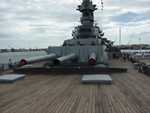 |
BB 63 5 inch guns
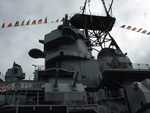 |
|
The Missouri was originally built with 20 five-inch, 38-caliber barrels. The five-inch gun has the ability to fire a bullet up to 9 miles during a shore bombardment and had an effective range of up to 5 miles against attacking aircraft. |
After our tour of the USS Arizona Memorial, the USS Bowfin, and the USS Missouri, we had to head back to the airport to go home. Memories of the ships I saw on this trip, both underwater and in Pearl Harbor, will stay with me for a long time.
See you on our next adventure,
Tom
|


